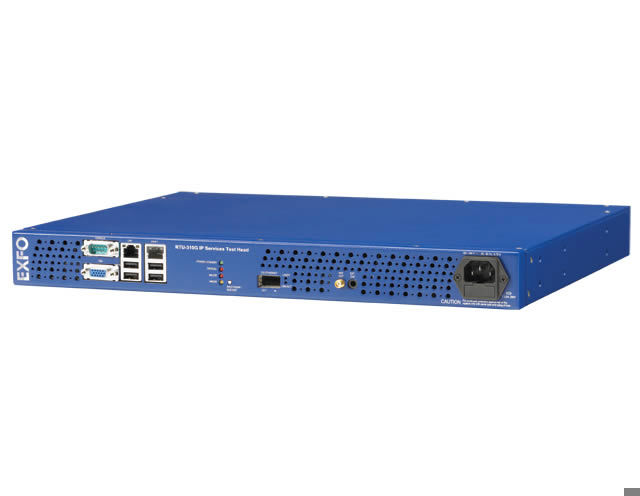



Caractéristiques principales

Applications
Description
The Choice for 10 Gigabit Ethernet Performance Assurance
EXFO’s RTU-310G IP Services Test Head is a carrier-grade test device that offers performance assurance capabilities for 10 Gigabit Ethernet-based services. Its suite of test applications provides all the measurements required for service turn-up, troubleshooting, as well as validating service-level agreements (SLAs) between service providers and their customers. This 1U rack-mounted, central office (CO)-based device—combined with its portable counterparts, EXFO’s award winning FTB-8510B Packet Blazer Ethernet Test Module and the FTB-8510G Packet Blazer 10 Gigabit Ethernet Test Module or the FTB-860 NetBlazer—simplify and accelerate the deployment of Ethernet services. In fact, the RTU-310G is the functional equivalent of the FTB-8510G and supports all the test features found in the portable version.
Flexible End-to-End Testing from a Centralized Point
With the RTU-310G IP Services Test Head, the user can perform end-to-end testing through control of the remote unit via the LAN connection under test. This unique approach gives service providers access to test results for each direction of test, which is essential to fully qualify Ethernet services. It is also possible to perform end-to-end testing by using the Smart Loopback mode where the remote unit will return traffic to the local unit by swapping packet overhead up to layer 4 of the OSI stack. For example, up to ten 1 Gigabit Ethernet (GigE) test patterns can be looped back simultaneously, allowing service providers to run multiple tests from different locations, all at the same time. This increases the test set’s flexibility and makes testing more efficient.
The RTU-310G tests connectivity in its native format: 10GBASE-xR or 10GBASE-xW used for transport of Ethernet-based LAN-to-LAN services. It can also be used to test next-generation SONET/SDH, hybrid multiplexers, dark fiber or xWDM networks running 10 GigE interfaces. The RTU-310G simplifies and speeds up the deployment of Ethernet services.
EtherSAM: The New Standard in Ethernet Testing
ITU-T Y.1564 is the new standard for turning up and troubleshooting Carrier Ethernet services. This methodology is completely adapted to today’s Ethernet services especially mobile backhaul and commercial services. Up to now, RFC 2544 has been the most widely used methodology. However, it was designed for network device testing in the lab, not for services testing in the field. ITU-T Y.1564 is the first testing standard developed for the field. It has a number of advantages over the RFC 2544 including validation of critical SLA criteria such as packet jitter and QoS measurements. This methodology is also significantly faster, therefore saving time and resources while optimizing QoS.
Contrary to other methodologies, EtherSAM supports new multiservice offerings. It can simulate all types of services that will run on the network and simultaneously qualify all key SLA parameters for each of these services. Moreover, it validates the QoS mechanisms provisioned in the network to prioritize the different service types, resulting in more accurate validation and much faster deployment and troubleshooting. EtherSAM is comprised of two phases, the service configuration test and the service performance test.
Service Configuration Test
The service configuration test consists in sequentially testing each service. It validates that the service is properly provisioned and that all specific KPIs or SLA parameters are met. A ramp test and a burst test are performed to verify the committed information rare (CIR), excess information rate (EIR), committed burst size (CBS) and excess burst size (EBS).
Service Performance Test
Once the configuration of each individual service is validated, the service performance test simultaneously validates the quality of all the services over time.
EtherSAM Bidirectional Results
EXFO’s EtherSAM approach proves even more powerful as it executes the complete ITU-T Y.1564 test with bidirectional measurements. Key SLA parameters are measured independently in each test direction, thus providing 100 % first-time-right service activation—that is the highest level of confidence in service testing.
RFC 2544 Test Suite
The RTU-310G IP Services Test Head can perform the RFC 2544 test suite for 10 GbE LAN/WAN interface at all frame sizes and at full line rate, allowing the provider to certify that the circuit is efficient and error-free at 100 % utilization. The IP services test head supports automated RFC 2544 testing, which helps ensure repeatable results. Automation also provides ease of use for field technicians by enabling accurate, efficient measurements and results through a clear and simple pass/fail indication. In addition, the IP services test head delivers reports that can be given to customers for future reference related to their specific SLAs.
Efficient Testing Leads to Reliable Performance
MPLS, MPLS-TP and PBB-TE: Carrier Ethernet Transport Solution Testing
As technologically sophisticated business and residential consumers continue to drive demand for premium, high-bandwidth data services such as voice and video, service providers worldwide are evolving their transport infrastructures to support these bandwidth and quality-intensive services. No longer is an all-IP core sufficient; providers must now expand their IP convergence to the edge/metro network, in a cost-effective, quality-assured manner. Ethernet has long been accepted as an inexpensive, scalable, data-networking solution in LAN environments. The stringent QoS expectations require solutions that tap into the cost-effectiveness of Ethernet without sacrificing the benefits of connection-oriented (albeit it costly) TDM solutions such as SONET/SDH.
Ethernet tunneling technologies such as Provider Backbone Bridge-Traffic Engineering or PBB-TE (also referred to as PBT) and transport MPLS address these requirements. These technologies enable connection-oriented Ethernet, providing carriers with a means of offering scalable, reliable and resilient Ethernet services. The PBB-TE and MPLS options on the RTU-310G offer service providers a comprehensive field tool to efficiently qualify Ethernet services from end to end, validating metro and core tunneling technologies.
EtherBERT™
Ethernet is increasingly carried across a variety of layer 1 media over longer distances. This creates a growing need for the certification of Ethernet transport on a bit-per-bit basis, which can be done using bit-error-rate testing (BERT).
BERT uses a pseudo-random binary sequence (PRBS) encapsulated into an Ethernet frame, making it possible to go from a frame-based error measurement to a bit-error-rate measurement. This provides the bit-per-bit error count accuracy required for acceptance testing of physical-medium transport systems. BERT-over-Ethernet should usually be used when Ethernet is carried transparently over layer 1 media, in cases such as Ethernet over DWDM, CWDM or dark fiber.
Ethernet QoS Measurement
Data services are making a significant shift toward supporting a variety of applications on the same network. Multiservice offerings such as triple-play services have fuelled the need for QoS testing to ensure the condition and reliability of each service and fully qualify SLA parameters. The RTU-310G allows service providers to simultaneously simulate and qualify different applications through its multistream application. The user has the capability to configure up to ten streams with different Ethernet and IP QoS parameters such as VLAN ID (802.1Q), VLAN Priority (802.1p), VLAN stacking (802.1ad Q-in-Q), ToS and DSCP. Specific stream profiles to transmit VoIP, video and data can be selected for each stream. Throughput, latency, frame loss and packet jitter (RFC 3393) measurements are also available simultaneously for each stream, allowing fast and in-depth qualification of all SLA criteria.
Ethernet Advanced Troubleshooting
The RTU-310G provides a number of advanced features essential for in-depth troubleshooting in the event of network failures or impairments. The advanced filtering option allows the user to configure up to 10 filters with each up to four operands, which will be applied to the received Ethernet traffic. Detailed statistics are available for each configured filter, providing the user with critical information required to pinpoint specific problems.
The RTU-310G also supports full-line-rate data capture and decode. This key troubleshooting tool enables field technicians to easily identify complex network issues. The comprehensive capture feature includes the capability to configure capture filters and triggers to quickly zero-in on network events.
Command and Control
Remote Management
The user interface for the RTU-310G IP Services Test Head is accessible via EX-Vu remote management software. It enables a remote connection to the instrument, as well as providing the graphical user interface (GUI) for test setup and device management. The EX-Vu application is supported on any Windows based workstation and allows for simplified remote testing and data analysis, as well as remote monitoring. Up to five simultaneous EX-Vu sessions can be supported via a standard Ethernet connection to the platform.
Automated Test Scripting
The RTU-310G supports .NET programming environment for users who prefer to build their automation test routines. The unit comes with a built-in macro-recorder, which allows users to easily record their test actions and automatically create test scripts; this also enables them to build standard test routines that can easily be accessed and run by technicians with little or no manual intervention. Scripts from the macro-recorder can be used as the basis for larger automation routines, which can be created or edited in any .NET environment.
Test Logger and Reporting
The RTU-310G supports a detailed test logger and test reporting tools, enabling users to view any errors/alarms that occurred during the test interval, which can then be used for post-processing of results or SLA conformance validation.


